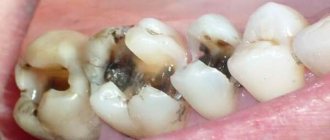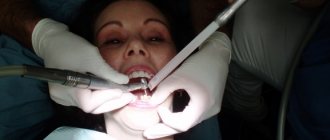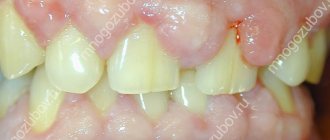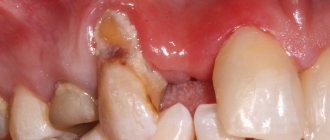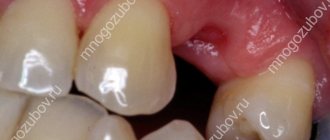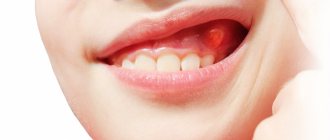Let's consider common questions that arise in patients with acute gum disease:
- How to treat an abscess on the gum in Samara
- What to do if pus appears on the gum
Moreover, precisely in this formulation. The definition of “abscess” in this case can include many different diseases, with different causes, mechanisms of development, different methods of prevention and treatment. The most common options will be discussed in this material.
Content:
- What is a tooth abscess
- Classification of abscess in dentistry
- Causes of the disease
- Signs of illness
- Breakthrough of purulent masses with an abscess
- Treatment of the disease
- How to prevent a tooth abscess from occurring
A tooth abscess is an unpleasant and dangerous dental disease. It can occur in anyone. It is impossible not to notice its presence, since acute pain appears in the affected area and accumulations of pus form. Let's take a closer look at what this disease is, how to recognize it and treat it.
Cyst.
A dental cyst is perhaps the most common problem that brings people to the dentist for emergency treatment, as it can suddenly and unexpectedly cause severe pain and inflammation in the jaw area (abscess). With a superficial examination, it is almost impossible to detect a dental cyst. An X-ray or MRI may be needed to identify the cyst. Growth in the tooth area is easily noticeable. The cyst should be detected as early as possible so that it is easier for you to heal and without the risk of further damage to the tooth.
What is a tooth abscess
This is an infectious process caused by the accumulation of purulent masses in the outer or inner part of the alveolar process of the upper/lower jaw. Pathology develops due to the abnormal activity of pathogenic microorganisms that accumulate in the soft pulpal (often dead) part of the tooth.
A small bulge appears on the gum. It is painful to the touch and causes discomfort in a person. Gradually, pus begins to accumulate in the “bump.” The difficulty is that you cannot open it yourself, or even more so, squeeze it out - under the influence of external pressure, the necrotic masses will not only come out, but will also penetrate into the deeper layers of the gum. Then they can get into the blood and lymph - the infection will spread throughout the body.
Classification of abscess in dentistry
Doctors say there are three types of tooth abscess:
- Desnev. Only the soft tissues of the mouth are damaged. But, if the disease is started, the periodontal ligaments and periosteum will be drawn into the inflammatory process. Then flux develops.
- Periapical. The pulp is affected. If treatment is not carried out in a timely manner, you will have to perform depulpation or, even worse, tear out the affected unit. More often, this type of disease is diagnosed in children with primary occlusion, which is why dentists have to remove a preschooler’s incisors, canines and molars without waiting for their natural replacement by molars.
- Periodontal. The abscess has a destructive effect on the root, so the tooth becomes loose and falls out prematurely.
The main danger of a purulent tooth abscess is that the pus that has accumulated inside the tumor can penetrate into the blood. Then a general intoxication of the human body will occur. Internal organs, bones, and brain come under attack. A person who ignores the presence of an abscess may develop meningitis, sepsis, and even die.
Causes of the disease
Most often, abscesses are encountered by people who pay insufficient attention to oral health. Thus, untimely treatment of caries, pulpitis, gingivitis, granuloma, stomatitis, cysts can lead to the described disease. It has also been noted that the risk group for the development of pathology includes people with weakened immune systems, diabetics, cancer patients, people with HIV, obesity, and hormonal disorders.
An injury often leads to the accumulation of pus in the jaw. A less common reason is mistakes made by the dentist when treating tooth canals.
A gingival abscess is usually the result of traumatic injuries to the oral mucosa. It often appears a few days after a person burns himself while drinking a hot drink or scratches his gums with hard food.
What diagnoses can fall into the category of “abscess on the gums”?
- Exacerbation of chronic periodontitis;
- Exacerbation of chronic gingivitis (periodontitis).
Suppuration also occurs after tooth extraction (alveolitis), with cancer, with fractures (osteomyelitis) - these conditions are also accompanied by the release of pus, but here the patient (in most cases) knows about the cause (a tooth was recently removed, there was a fracture, etc.). d.). Sometimes manifestations of diseases of the mucous membranes are confused with ulcers - aphthous stomatitis, herpetic stomatitis and others, which also appear as a white (white-yellow/gray) area of the mucous membrane with a red rim around, but as such there is no pus there, and the causes of these conditions are also different. Therefore, we will talk more about periodontitis and periodontitis.
Signs of illness
It is almost impossible not to notice the presence of pathology - the symptoms are always very clear. Anyone, even those far from the medical field, can understand that something is wrong with their gums.
- First there is an acute toothache. It becomes more pronounced if you press on the unit, touch it, or knock on it. It intensifies if the patient drinks or eats something hot or cold.
- Soon the gums swell. Even the cheek may swell. This indicates that the inflammation is spreading quickly.
- A bulge forms on the gum. At first it is red or with a bluish tint. But it also happens that it is not there, and pus simply begins to ooze from the gums.
Due to the purulent masses, the patient has an unpleasant taste and a foul odor appears from the mouth. It is not possible to remove it using standard hygiene products - a toothbrush and toothpaste, since pus continues to actively form after brushing your teeth.
An advanced abscess contributes to an increase in body temperature, decreased appetite, and decreased performance. In many patients, the cervical lymph nodes become enlarged.
Symptoms
The main symptom of a tooth abscess is pain. It is localized in one place and intensifies when pressed or chewed. The tooth becomes sensitive to cold, hot or sour foods. If the tumor appears in the upper jaw, pain spreads along the trigeminal nerve.
The following manifestations of pathology are also common:
- malaise, weakness, headache;
- temperature increase;
- swelling and redness of the gums;
- swollen lymph nodes;
- the appearance of greenish discharge;
- the face becomes asymmetrical;
- if there is pus in the mouth, an unpleasant odor and bitter taste appear.
Breakthrough of purulent masses with an abscess
Often the “bump” grows, swells, and then bursts. Then the pus inside it flows out. After this, the pain goes away and the patient’s well-being improves significantly. But this does not mean that the problem is a thing of the past. It should be remembered that with an abscess, fistula tracts often form. They serve as a protective reaction of the body - they ensure the unhindered outflow of pus and prevent the inflammatory process from further progressing.
The disease may recur. Purulent exudate is able to penetrate into the tissue surrounding the tooth. Therefore, even if the “bump” has burst, you still need to make an appointment with the dentist so that the doctor can conduct an examination and tell you what to do to prevent the disease from returning.
How to treat an abscess on the gum with folk remedies?
In both cases, the cause of the development of the process is an infection that sits deep in the gum or bone. This means that we still won’t be able to influence it directly. Traditional methods (rinsing with herbs, applying propolis, etc.) usually bring their results: the fistula really goes away for a while. BUT! All these methods remove the effect, not the cause! Until the microbial contamination is removed, inflammation will progress. It won’t cause such discomfort, but it certainly won’t go away on its own.
Therefore, treatment should begin with a visit to the dentist to determine the cause. And only then, when you identify the cause and begin to fight it together with the doctor, you can also use traditional therapy, since rinsing with herbs really gives a good result after removing the stone, and, for example, sea buckthorn oil slightly speeds up the healing of wounds on the mucous membrane.
Treatment of the disease
You should not try to cure a purulent “bump” on your own. Therapy should be carried out by an experienced dentist. First, the specialist carries out an examination and carries out the necessary diagnostic measures. Then he proceeds to opening the purulent formation. To do this, he uses a scalpel or laser beams. Since the drainage procedure is performed under local anesthesia, the patient does not feel pain.
The next step is to wash the wound and treat it with antiseptics, and apply antibacterial compounds. It also happens that drainage is installed in the affected area for several days to avoid re-accumulation of pus.
Afterwards, the tooth is treated or pulled out. In the first case, the nerve is removed. To do this, medicine is put into the unit and after a few days the dead nerve is removed. Afterwards, the canals are cleaned and sealed. Filling material or an individually made inlay is placed on top.
A tooth is pulled out only in advanced cases, when the roots have become unusable and cannot be treated. To prevent this, you need to see a doctor in a timely manner, and not hope that the disease will go away on its own.
If the patient complains of acute and pronounced pain, he is prescribed a painkiller. Most often these are tablets, but it is also possible to use a special anesthetic gel.
In order to achieve a guaranteed victory over inflammation and prevent recurrence of the abscess, the patient is also prescribed an antibiotic. The average course for the described diagnosis is from five to seven days. It is unacceptable to interrupt it in the middle because the condition has improved - the disease may return.
Local treatment, carried out at home after the dental surgeon has opened the abscess, consists of applying compresses with antibacterial compounds and performing therapeutic rinses. These procedures stimulate regeneration and accelerate tissue renewal.
How to prevent a tooth abscess from occurring
To reduce the likelihood of developing a disease, you need to constantly follow these simple rules:
- brush your teeth two to three times a day;
- After each meal, rinse the mouth with warm water;
- use only high-quality hygiene products, carefully choose toothpaste, brushes, dental floss, irrigators, dental lotions and rinses;
- eat a balanced diet, eat as many fresh fruits and vegetables as possible, make sure that your diet includes solid foods that require thorough chewing;
- visit the dentist twice a year;
- undergo professional oral hygiene procedures annually;
- promptly treat all emerging diseases of the teeth and gums, prevent the progression of caries, pulpitis, and gingivitis.
It is also important to pay special attention to gum health. If they often become inflamed and bleed, perhaps the body lacks vitamins, minerals, or the tartar has become too large and is putting pressure on the delicate gum tissue. It is necessary to establish the cause of the problem and be sure to eliminate it.
People who take good care of the health of their teeth are much less likely to encounter an abscess and the complications caused by it. Therefore, do not forget the importance of maintaining oral hygiene.





